Migraines

Published: 20th June, 2014 in: Health Advice
Migraines are a type of headache that affect up to one in seven people in the UK. They are usually felt as a throbbing pain at the front or one side of the head, often with nausea, vomiting or increased sensitivity to light. These types of headache can last up to several days, so can be a major disruption to someone who suffers with them. Women are three times more likely to get them than men and they can occur at any age, but are most common from adolescence up to the age of around 50.
What is a migraine?
There are two types of migraine:
Classical migraines start with warning signs that a migraine is imminent, known as an aura. The warning signs can include:
- visual problems, such as flashing lights or blurred vision
- neck, shoulder or limb stiffness with tingling or numbness sensations
- co-ordination problems
- poor concentration.
The aura lasts for around an hour before headache symptoms start. Around one third of people experience an aura before their migraine.
Common migraines do not have an aura before the headache.
The intense, throbbing headache associated with migraines occurs with both classical and common types. In common migraines other symptoms can also occur including nausea, vomiting and increased sensitivity to light, sound, and smells. This is why some people with migraines prefer to rest in a dark, quiet room. These symptoms often begin at the same time as the headache, and normally subside when the headache eases.
Some symptoms are associated with both classical and common migraines, but not everyone will experience them. These symptoms include poor concentration, sweating, feeling very hot or very cold, abdominal pain that may cause diarrhoea, and a frequent need to urinate.
The exact symptoms experienced during a migraine vary between patients. The frequency of attacks can also vary, with some people suffering several times a week and others only experiencing them occasionally (sometimes with years between attacks). A migraine can last anywhere between four hours and three days with the patient sometimes feeling tired for up to seven days after the attack.
There are five stages to a migraine, although not everyone goes through all stages:
- Stage 1 – ‘Prodromal’ (pre-headache stage) – Some people experience changes in mood, energy levels, behaviour and appetite, and sometimes aches and pains occur several hours or days before an attack.
- Stage 2 – Aura – The symptoms of an aura are associated with classical migraine and include visual problems such as flashing lights or blurred vision, neck, shoulder or limb stiffness with tingling or numbness sensations, co-ordination problems and poor concentration. This stage normally lasts between 15 minutes to an hour.
- Stage 3 -Headache stage – This is usually felt as a pulsating or throbbing pain on one side of the head. Nausea, vomiting, and extreme sensitivity to light, sound and smell occur with common migraines. Often the patient has to lie down in a dark, quiet room. This stage last for anywhere between four hours and three days.
- Stage 4 – Resolution stage – Most attacks gradually fade away. Sometimes the headache stops suddenly after vomiting. Sleep often helps to relieve symptoms too.
- Stage 5 – ‘Postdromal’ or recovery phase – There may be a period of tiredness and weakness for up to seven days afterwards.
What triggers a migraine?
The exact reasons why migraines occur are not fully understood, but it may have something to do with one of the chemical transmitters in the brain, and some migraine treatments work by activating receptors sensitive to these chemicals to help stop the attack.
There is a theory that migraines occur as a result of a disorder of brain function. This may explain some of the sensations that may be experienced during an attack, such as poor concentration and co-ordination.
Migraines are often be triggered by factors including:
- Physical – strenuous exercise, poor posture or tension in neck or shoulders, change in sleep patterns, travelling for long periods of time.
- Emotional – stress, anxiety, tension, excitement.
- Environmental – loud noises, bright or flickering lights, certain smells.
- Dietary – some food or drink (commonly chocolate, cheese, alcohol, caffeine) inadequate fluid intake, missing meals.
- Medicines – contraceptive pill, hormone replacement therapy (HRT).
Patients may find it useful to keep a diary to help identify triggers that cause migraines or make them worse, and avoid these triggers in the future.
Treating migraines
There are a number of different medicines available to help with the symptoms of migraine, up to a few years ago those that could be purchased from a pharmacy centred on paracetamol and codeine, or an anti-inflammatory like ibuprofen, and these can be effective and help reduce or get rid of the symptoms. There are also preparations such as Migraleve pink that contain a medicine that stops the feeling of nausea that can be associated with a migraine alongside a regular painkiller.
More recently a prescription medication called Sumatriptan has been made available for sale under certain circumstances. This is available as Imigran recovery and can be very effective at stopping a migraine attack from developing.
Sumatriptan is not suitable for everyone, and for sale through a pharmacy the pharmacist will need to do an initial consultation to ensure it is suitable. There needs to be a clear prior diagnosis of migraine before it can be sold, and the medication cannot be sold for people under 18 or over 65. There are a number of other reasons why the medication may not be suitable, and the pharmacist may either recommend an alternative medication, or refer on to the GP so that something can be prescribed if necessary.
If migraine attacks are causing problems or becoming regular there may be treatments available to help prevent them from occurring, but these will require a prescription from the GP.